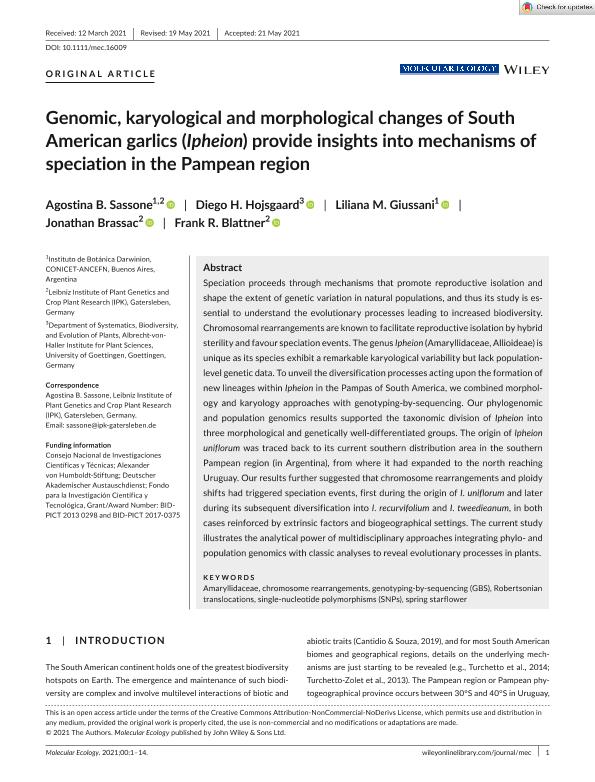Artículo
Genomic, karyological and morphological changes of South American garlics (Ipheion) provide insights into mechanisms of speciation in the Pampean region
Sassone, Agostina Belén ; Hojsgaard, Diego H.; Giussani, Liliana Mónica
; Hojsgaard, Diego H.; Giussani, Liliana Mónica ; Brassac, Jonathan; Blattner, Frank R.
; Brassac, Jonathan; Blattner, Frank R.
 ; Hojsgaard, Diego H.; Giussani, Liliana Mónica
; Hojsgaard, Diego H.; Giussani, Liliana Mónica ; Brassac, Jonathan; Blattner, Frank R.
; Brassac, Jonathan; Blattner, Frank R.
Fecha de publicación:
04/06/2021
Editorial:
Wiley Blackwell Publishing, Inc
Revista:
Molecular Ecology
ISSN:
0962-1083
e-ISSN:
1365-294X
Idioma:
Inglés
Tipo de recurso:
Artículo publicado
Clasificación temática:
Resumen
Speciation proceeds through mechanisms that promote reproductive isolation and shape the extent of genetic variation in natural populations, and thus its study is essential to understand the evolutionary processes leading to increased biodiversity. Chromosomal rearrangements are known to facilitate reproductive isolation by hybrid sterility and favour speciation events. The genus Ipheion (Amaryllidaceae, Allioideae) is unique as its species exhibit a remarkable karyological variability but lack population-level genetic data. To unveil the diversification processes acting upon the formation of new lineages within Ipheion in the Pampas of South America, we combined morphology and karyology approaches with genotyping-by-sequencing. Our phylogenomic and population genomics results supported the taxonomic division of Ipheion into three morphological and genetically well-differentiated groups. The origin of Ipheion uniflorum was traced back to its current southern distribution area in the southern Pampean region (in Argentina), from where it had expanded to the north reaching Uruguay. Our results further suggested that chromosome rearrangements and ploidy shifts had triggered speciation events, first during the origin of I. uniflorum and later during its subsequent diversification into I. recurvifolium and I. tweedieanum, in both cases reinforced by extrinsic factors and biogeographical settings. The current study illustrates the analytical power of multidisciplinary approaches integrating phylo- and population genomics with classic analyses to reveal evolutionary processes in plants.
Archivos asociados
Licencia
Identificadores
Colecciones
Articulos(IBODA)
Articulos de INST.DE BOTANICA DARWINION (I)
Articulos de INST.DE BOTANICA DARWINION (I)
Citación
Sassone, Agostina Belén; Hojsgaard, Diego H.; Giussani, Liliana Mónica; Brassac, Jonathan; Blattner, Frank R.; Genomic, karyological and morphological changes of South American garlics (Ipheion) provide insights into mechanisms of speciation in the Pampean region; Wiley Blackwell Publishing, Inc; Molecular Ecology; 30; 15; 4-6-2021; 3716-3729
Compartir
Altmétricas



